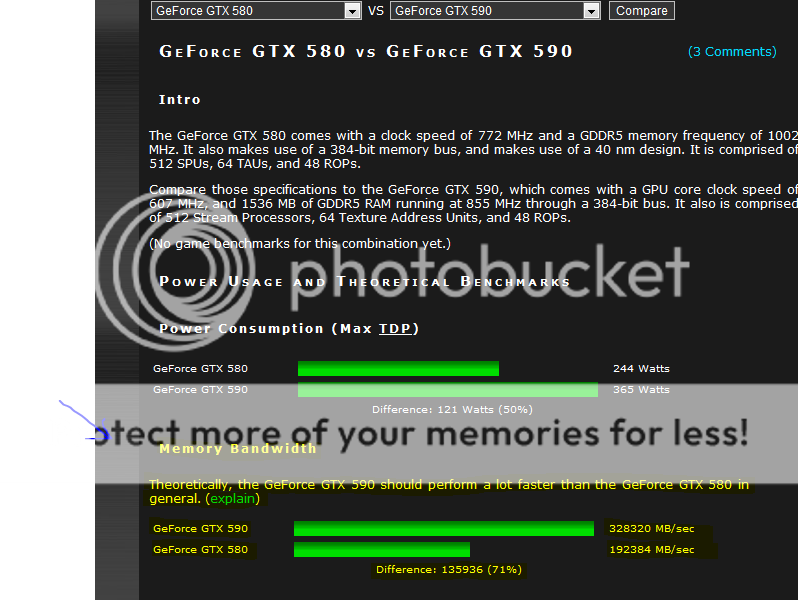PCgamer81 :
You are the one arguing semantics, and very stubbornly and unyieldingly at that. If you remember correctly, this discussion began with me merely stating that it is more beneficial irrespective of VRAM and whether or not it is doubled. So saying that the bandwidth is effectively doubled as it pertains to performance and not as it pertains to actual facts has no bearing on my original claim. In fact, it validates it.
Furthermore, HWcompare isn't just some guy with a calculator. They are a respected and oft quoted team of professionals providing information and actual in-game benchmarks relating to the products displayed on their site. They go to great lengths to be as informative as humanly possible.
I highly doubt they would leave something so ambiguously omissible.
And if they did, it can only be because it relays what is true for all intents and purposes. That the bandwidth is improved, whether in application, theory, performance, or what have you. And it is. The performance jump as it handles high levels of AA and AF is indicative of that much.
The bandwidth did not improve, only the effective bandwidth did. No amount of arguing will change that. I'm not saying that they aren't respected nor that they're stupid or anything like that, only that they did not point this out.
Nothing will make increasing GPU count also increase the memory bandwidth by an amount that is more or less proportional to the increase in active GPU count in the system. Nothing will change that. It's just like the DDR argument. It get's simplified because not everyone understands it, let alone cares. However, that does not change the fact that what we call DDR3 1600MHz is not really 1600MHz, it is 800MHz that transmits data on both ends of a clock cycle.
Call it semantics, but that is how it is. This isn't subjective and no one can change that either. The bandwidth did not double, plain and simple. You can try to argue about it further, but this is something that neither you nor I nor anybody else can change.
Also, if you read their pages, they clearly state that these aren't in game benchmarks and that they aren't even really benchmarks, just math. They even tell you how they got their answers. Their *tests* are even more synthetic than a synthetic benchmark. They even tell you that real world usage can and will vary. There's nothing WRONG about how they do this and they tell you that things can vary, but they aren't really telling you how things work out in reality, nor are they trying to complicate things anymore than this stuff already is. They probably don't even care that the 6990 didn't actually have that much bandwidth, it just pretended to have it. They probably also don't care that DDR3 1600 is really 800MHz memory and the same is true for other such situations.
The argument may have started out with me saying that the bandwidth was both the same and effectively the same as a single GPU, but I've obviously realized why that was wrong and am now right. It's not enough that I admit that I was wrong before, you're bothered by me now that I am correct. At least I admited when I was wrong, the least you can do is either prove me wrong (you can't because I know for a fact that I'm right, but you can try) or admit that what I'm saying now is the absolute truth about this.
Also, for triple 1080p and 5760x1200, 2GB GTX 680s, even in triple SLI, can't do any more than FXAA in many games because of thier VRAM limit, so having multiple GPUs each with their own VRAM does not seem to help this at all.
http://www.hardocp.com/article/2012/04/25/geforce_gtx_680_3way_sli_radeon_7970_trifire_review/1
Notice how the 7970's problems have nothing to do with VRAM because it is not limited be VRAM capacity nor bandwidth, but the 680 can't even do proper AA for such a system. Also, a lot of these games (such as Batman) are Nvidia-optimized and the 7970s are using the original drivers they had at launch do to AMD's new drviers not working on the 7970 in eyefinity, so don't take the 7970's poor perfomrance to heart. Despite it's poor performance, it has nothing to do with VRAM capacity bottlenecks like the 680's does and [H] makes that very clear. If it confuses you or anyone else, I'd be glad to explain things in further detail (where I can) than [H] did.
If three 680s have a VRAM advantage over a single 680 like you suggest (I doubt it), then they would be unable to do even as well with AA and quality settings as the three 680s did here. Oh, and unlike your link, this is as not out of date (at least, until ground breaking drivers for Nvidia and/or AMD come out, but they wouldn't change VRAM capacity usage, just performance, feature addition/fixing, compatibility, and bug fixes).





